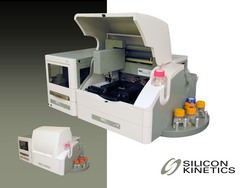Oct 5 2010
Silicon Kinetics Inc., a leading life sciences instrumentation company which released the world's initial 3D label-free biosensor surface for analysing biomolecular reactions, proclaimed the general obtainability of SKi Pro X1000. This advanced biosensor device is the latest supplement to the SKi Pro base for performing the non-labeled interaction studies.
 SKi Pro™ X1000, high-sensitivity biosensor array reader
SKi Pro™ X1000, high-sensitivity biosensor array reader
Hus Tigli, Silicon Kinetics’ Chairman and CEO stated that the flexibility of the device is based on the specific biomolecular reactions involved in the examination process and he explained that the SKi Pro X1000 could perform detection in the order of 100 ng/ml antigen-antibody reactions in the non-fluidic, microplate structures. He added that if the same device is deployed for the interactions in the fluidic cell pattern, it could only identify less than 1 ng/ml EGF-anti-EGF reactions.
Silicon Kinetics SKi Pro is a unique non-labeled biomolecular reactions evaluation base which permits the study to be carried out in multiple well unit systems and precise kinetic calibrations in the fluidic cells, all employing the one and the same monitoring device and the identical surface texture. This specific twin-format characteristic of the instrument thus helps in saving the time for the entire methodology advancement and promotes regularity and ideal equivalence of the test results throughout many departments in drug detection and its development. The working of the device is based on the nano-pore optical interferometry (NPOI) technology.
With the in-built robotics, SKi Pro X1000 self-regulates the experimental tests in a non-fluidic plate with 96-wells with a measurement of eight wells simultaneously. The reaction tests can be performed at a widest temperature in the range of 150 C to 600 C. The flow rates can be programmed within a range of about 1 µl/m to 100 µl/m in the fluidic cell structure.
Source: http://www.siliconkinetics.com